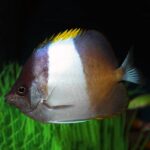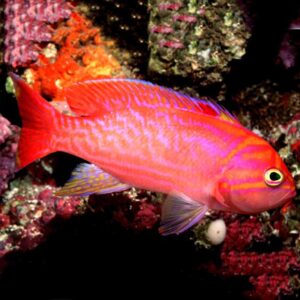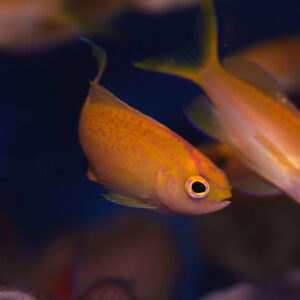Description
The Pearlscale Butterfly Red Sea, scientifically known as Chaetodon paucifasciatus, is a visually striking fish with a maximum size of around 8 inches (20 cm). It has a disc-shaped body. They have a vibrant red tail. The body is accented by black vertical stripes that extend from the dorsal fin to the anal fin. The fins are translucent with hints of yellow and black.
Natural Habitat:
In its natural habitat, the Pearlscale Butterfly Red Sea inhabits coral reefs and lagoons with moderate water movement. These areas provide a diverse array of coral formations and rocky outcrops. The fish seeks shelter and forages among the coral branches and crevices. The water is warm, with temperatures ranging from 77°F to 82°F (25°C to 28°C), and the salinity levels are consistent with that of a marine environment.
Keeping Pearlscale Butterfly Red Sea:
Keeping the Pearlscale Butterfly Red Sea healthy requires moderate care and attention. It is considered to be of moderate difficulty due to its specific dietary and environmental requirements. Provide a well-maintained aquarium with stable water parameters, including a temperature of 77°F to 82°F (25°C to 28°C) and a pH range of 8.1 to 8.4. Maintain proper filtration and aeration to ensure good water quality.
Special Requirements and Feeding:
The Pearlscale Butterfly Red Sea has a specialized diet consisting mainly of coral polyps. In captivity, it can be challenging to replicate this diet. Therefore, offering a variety of high-quality marine-based foods is crucial. Provide a balanced diet that includes marine flakes, pellets, frozen or live foods such as brine shrimp, mysis shrimp, and chopped seafood. Supplement their diet with small pieces of coral or zooplankton to satisfy their natural feeding instincts.
How Many Should I Keep:
It is generally recommended to keep the Pearlscale Butterfly Red Sea as a solitary specimen or in mated pairs. They can become territorial towards similar species or smaller tankmates. Providing adequate space and hiding spots is essential to reduce aggression and stress.
Lighting Preference:
The Pearlscale Butterfly Red Sea prefers moderate lighting in the aquarium. Mimic their natural habitat by providing a combination of subdued and bright lighting. Use a combination of LED or fluorescent lights to create suitable lighting conditions.
Suitable Tank Mates:
When selecting tank mates for the Pearlscale Butterfly Red Sea, it is important to consider their compatibility. Peaceful and non-aggressive species that can coexist in a reef environment are suitable companions. Avoid keeping them with aggressive or territorial fish that may pose a threat.
Reproduction in the Wild:
The Pearlscale Butterfly Red Sea, or Chaetodon paucifasciatus, reproduces through sexual reproduction in the wild. During the breeding season, which can vary depending on the region, males and females engage in courtship behaviours to initiate spawning.
Breeding Chaetodon paucifasciatus:
Breeding the Pearlscale Butterfly Red Sea in captivity, also known as Chaetodon paucifasciatus, can be challenging due to their specific requirements. Here is a detailed overview of the breeding process:
- Set up:
Provide a well-established aquarium with plenty of live rock, coral branches, and hiding spots. Maintain stable water conditions, including a temperature of 79°F to 82°F (26°C to 28°C), a pH range of 8.1 to 8.4, and proper filtration.
- Courtship/Spawning:
Courtship behaviours involve the male displaying vibrant colours, fluttering movements, and chasing the female. Once the female accepts the male’s advances, they perform a vertical ascent toward the water surface, releasing their gametes simultaneously. Spawning usually occurs early in the morning.
- Rearing:
After spawning, the fertilized eggs float freely in the water column. It is crucial to provide a separate rearing tank with suitable conditions for the eggs and larvae. The tank should have gentle water flow, optimal water quality, and appropriate food for the developing larvae. Artemia nauplii and other small zooplankton are commonly used as initial food sources.
Sexual Dimorphism:
There is no significant sexual dimorphism observed in the Pearlscale Butterfly Red Sea. Both males and females exhibit similar body shape, colouration, and fin morphology.
Distribution:
The Pearlscale Butterfly Red Sea is naturally distributed in the Red Sea and the Gulf of Aden. It is not a captive-bred or line-bred strain but originates from the wild population found in these regions.
Summary:
The Pearlscale Butterfly Red Sea, scientifically known as Chaetodon paucifasciatus, is a stunning fish with specific care requirements. It exhibits vibrant colours, has a maximum size of approximately 8 inches (20 cm), and prefers a temperature range of 79°F to 82°F (26°C to 28°C) and a pH range of 8.1 to 8.4. It is a bit delicate in terms of care level and requires a well-maintained aquarium with stable water conditions. This species feeds on coral polyps, so providing a varied diet with marine-based foods is crucial. It is suitable for reef tanks with compatible, non-aggressive tank mates. In the wild, they reproduce through sexual reproduction, with courtship and spawning behaviours. Breeding them in captivity requires a well-set-up aquarium, courtship rituals, and proper rearing of the eggs and larvae. The Pearlscale Butterfly Red Sea is naturally distributed in the Red Sea and the Gulf of Aden, originating from the wild population.
The Fish pictured here are representative only and the livestock you receive may vary in pattern, coloration, and shape.









 API Stress Coat + 16oz ( pond version )
API Stress Coat + 16oz ( pond version )
Reviews
There are no reviews yet.